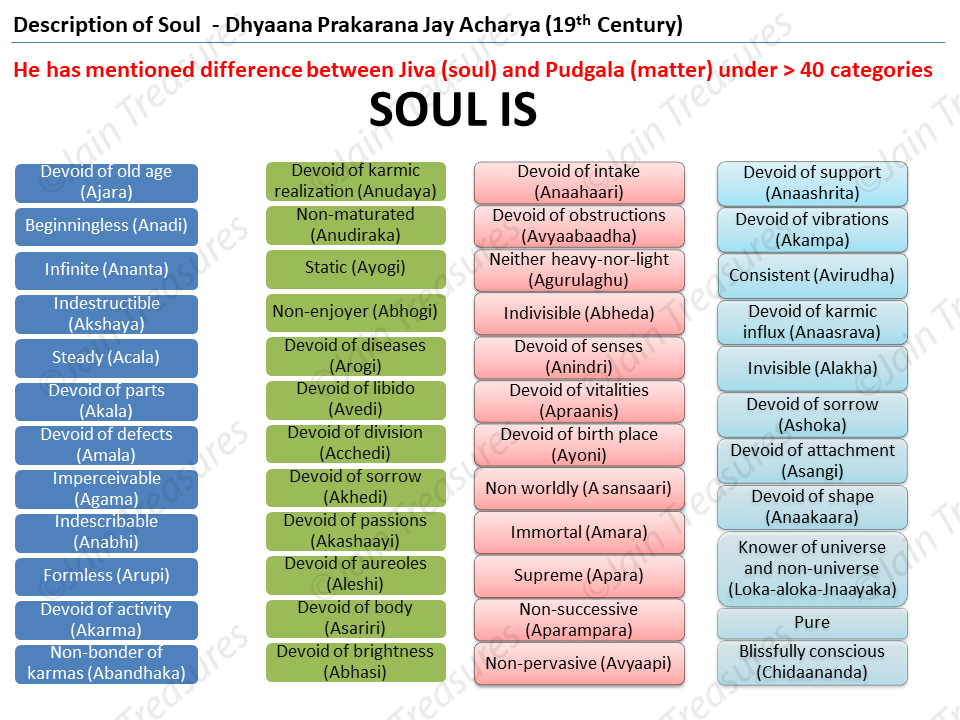Bhagvati Sutra and the Tattvartha Sutra succintly define Jiva as Upayoga (application or utility of consciousness i.e. caitanya). It is prana (power of life force) known by its experience and application. This is understanding soul from one perspective. Of course, there are infinite manifestations (e.g. feeling, willing, etc) of comprehending this sublime reality.
It is formless, intertwined with a physical body until it achieves liberation when it once and for all times remains in its pure form. It experiences the fruits of its action (karma) and upon self-realisation and staunch faith in the duality of soul and matter, strives to get rid of all karmic burden and achieve infinite knowledge, bliss, intuition and energy.
Thus, Jain philosophy is a dualist philosophy – believes in an independent existence of a physical body (matter) and consciousness (Jiva / soul).


Acharya Siddhasen Diwakar has enumerated six eternal truths dealt in the Acharanga Sutra

The key manifestation of these truths are:
(i) There is no supreme entity or God that has created the world or exercises jurisdiction on it.
(ii) All souls can reincarnate within four realms (plants / animals, heavenly beings, hellish beings and as humans) depending on the karmas bound until it achieves liberation. Humans are blessed and endowed with a fecund mind and therefore are privileged to use their discretion in determining what is best for their spiritual progress and to discard karmic baggage as efficiently and quickly as possible.
(iii) Pleasure and pain is self inflicted. Therefore each soul is independent and has the power to determine its own fate.
Nature of Soul as elucidated in the Acharanga Sutra

Whilst the soul transmigrates in the four realms (coloured green), it can be endowed with various physical bodies:
(i) Audarika body is the physical body which all plants, animals and humans possess
(ii) By birth, heavenly beings and hellish beings possess vaikriya body which endows them with special powers as a result of this body for example they can transform themselves into various forms.
(iii) Aharak body can be attained by highly spiritual ascetics through penance and restraint. It can be thought of as astral body enabling them to travel to different universe where there is a living tirthankar (e.g. Simmandhar swami in Mahavideha Kshetra) to resolve any spiritual doubts.
(iv) Taijas body is known as fiery body / electrical body. It accompanies the soul through all reincarnations until it achieves liberation.
(v) Karmana body is the subtlest of all bodies and all accompanies the soul through all its reincarnations until it achieves liberation. It is akin to a ledger havings records of the entire karmic account through all the past lives. What is unique amongst the Jains compared to all other Indic philosophies is that karma is considered as particles of matter similar to our physical body, the only difference being that it is very subtle and thus cannot be visualised.

Within the Jain universe, the central pillar is called the Trasa Nadi meaning an area where souls can be mobile. In all other regions souls are immobile.

Within the Jain universe, the central pillar is called the Trasa Nadi meaning an area where souls can be mobile. In all other regions souls are immobile.
Soul has infinite qualities as per the Jain doctrine. Most Jains would know that the pure soul has four properties: BIKE (infinite Bliss, infinite Intuition, infinite Knowledge & infinite Energy). However, can you think of more qualities of the soul?
Jay Acharya, the fourth head of the Terapanth sect, has enumerated many qualities as shown below.
